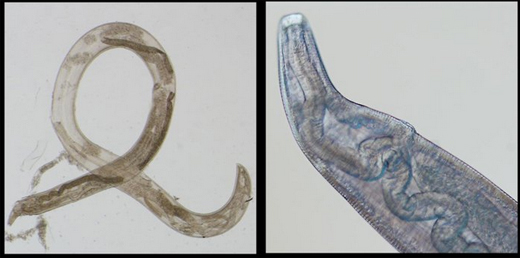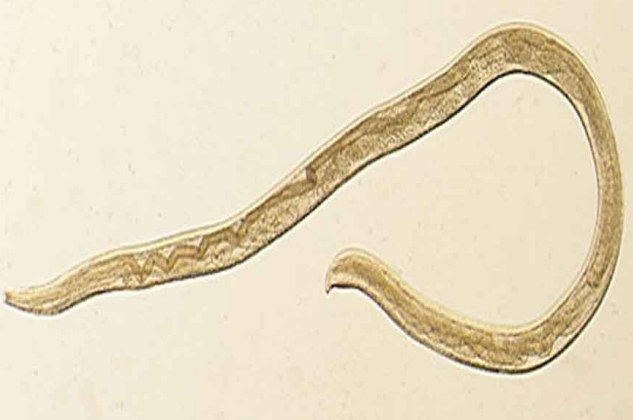Woman digs out rare wriggly roundworms from her eyes after developing irritation
Woman digs out rare wriggly roundworms from her eyes after developing irritation
Mangalore Today News Network / Yahoo
November, 05 2019: In what is the second only case discovered ever, a trail run near California coast may have led a woman face a zootonic disease. Turns out, the woman contracted an infection with a rare parasitic eye worm.


There has been only one other human case of the disease, when a 26-year-old Oregon woman was infected with it, reported Live Science.
In the report of the case published in the journal Clinical Infectious Diseases on October 22, the woman contracted the worm, which usually infects cows.
According to Live Science, the 68-year-old Nebraska woman, who spends her winters in California’s Carmel Valley, was there in March 2018 when she felt irritation in her right eye and flushed it with tap water.
What emerged from her eye, however, was what horror stories are made of.
A 1.3-centimetre long wriggly roundworm emerged from her eye, following which she looked closely at her eye and discovered a second roundworm.
According to the report, she managed to remove it as well.
The women then visited an ophthalmologist, who found a third roundworm, known as a nematode, from the woman’s eye. The doctor preserved it. She was asked to continuously flush her eyes and to remove any more worms and was given medicines to prevent bacterial infections.
The preserved worm was sent to the CDC and researchers came to the conclusion that the woman was infected with a species of eye worm called Thelazia Gulosa.
The worm usually does not infect humans but infects cattle.
While medical practitioners failed to find out how she got the infection in first place, the 68-year-old runner recalled one of her trail runs.
She told the doctors that she once ran into a group of flies during her run in Carmel Valley in February 2018. She recalled “swatting the flies from her face and spitting them out of her mouth,” the report added. It could be the moment when she got introduced to the injection, the report further added.
Turns out, after returning to Nebraska, she pulled out a fourth critter as well. In her case, she continued with irritation of her eyes for two weeks, following which the eye irritation disappeared.
Speaking about the same, the study authors said that having a second case in the US within two years could be an indication that the T. gulosa infections are becoming more common in domestic cows and thus resulting in a spillover in humans.
They also noted that the worm that was examined had eggs developing, indicating that humans were suitable hosts for it as well.
- Dr Veerendra Heggade releases logo of DK Journalists’ Conference
- Belthangady: Man, 2 children fall off bike after spotting elephant on road
- Udupi : Home nurse arrested for theft of jewellery worth Rs 30 lakhs
- Vittal: Man found dead in house
- Minor taken into custody for sexually harassing young woman
- GP Vice President, daughter injured in bee attack at Kotathattu
- 2 sustain serious injuries in car-fish vehicle collision near Kumbhashi
- Mangaluru: Lokayukta raid on office of Mines Department officer
- Arrested Maoist Srimati seeks legal assistance to defend herself in a murder case
- Udupi: Ambulance carrying body of slain Naxal Vikram Gowda, overturns
- Kasargod: Youth arrested for placing stones on railway tracks
- Karkala: Over 20 teams launch hunt for associates of slain Naxal Vikram Gowda
- Udupi: Young woman missing from Gundibailu
- Watch: Guests shower ₹ 20 lakh cash at UP wedding procession
- Kerala man fined Rs 2.5 lakh for obstructing Ambulance’s path, incident recorded on video
- Narayana Murthy ‘can’t help falling in love’ as he sings Elvis Presley song for Sudha Murty
- On camera, biker lands on car roof after high-speed collision
- Drunk man drives Mahindra Thar on railway track to shoot a reel, gets stuck
- Yoga teacher buried alive in Karnataka, escapes death using breathing techniques
- World’s first wooden satellite, developed in Japan, heads to space
- Britain’s King Charles on a personal visit to Bengaluru
- Ratan Tata’s will: unlimited care for pet dog Tito, provisions for house staff, butler
- Ratan Tata (1937-2024): A corporate giant who was guided by his heart
- Nepal’s Nima Rinji Sherpa becomes youngest to scale 14 tallest peaks
- What is Slot Mahjong Ways 2?
- Video: World’s largest residential building that houses over 20,000 people
- Doctors, armed forces, top India’s trust list; Politicians at the bottom
- CM Siddaramaiah urges FM Sitharaman to enhance NABARD loan in state
- Baseless: Adani Group vows to take legal recourse after US bribery indictment
- Khalistani groups threaten fresh protests against Hindus in Canada: Sources
- India slams Canada report on Nijjar murder plot, calls it ludicrous
- Education Minister can’t speak Kannada: Student’s remark draws action
- PM Modi meets Caribbean leaders at India-CARICOM Summit to strengthen ties
- Malayalam actor Meghanadhan dies at 60
- Arrest warrant issued for Gautam Adani, nephew Sagar in bribery case
- PM Modi receives Dominica’s highest national honour
- Maharashtra records 65% voter turnout in high-stakes assembly elections
- UP woman’s body found in sack, family says she was killed for backing BJP
- CITY INFORMATION
- TRAVEL
- TOURIST INFORMATION
- HEALTH CARE
- MISCELLANEOUS




 Write Comment
Write Comment E-Mail
E-Mail Facebook
Facebook Twitter
Twitter  Print
Print 


